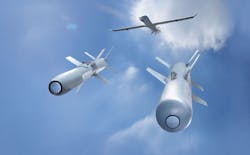Air Force reaches out to industry for machine autonomy and advanced sensors for air-delivered munitions
EGLIN AIR FORCE BASE, Fla. – U.S. Air Force researchers are asking industry to develop enabling technologies for bombs and missiles that involve autonomous target recognition; weapons autonomy; weapons cyber security; electro-optical sensors; navigation; multi-mode radar; and modular open-systems designs.
Officials of the Air Force Research Laboratory Munitions Directorate at Eglin Air Force Base, Fla., issued a broad-agency announcement last week (FA8651-22-S-0001) for the Air Delivered Effects project.
Air Delivered Effects consists of 20 separate research topic areas that industry will pursue over the next five years. These involve sensors, sensor processing, machine autonomy, cyber security, open-systems design, weapon airframes, weapons and effects simulation, and warheads and fuzes.
Autonomous target recognition involves seeker hardware and software technology for conventional guided weapons. This involves signal and image processing; pattern recognition; computer vision; deep learning; machine learning; and cooperative weapon seekers able to hand-off targeting information to one-another.
The technical point of contact is David Gray, who can be reached by phone at (850) 883-0849, by email at [email protected], or by fax at (850) 882-3344.
Weapons autonomy technology research involves bio-inspired sensing and wide-field-of-view seeker hardware and software algorithms for use in contested environments. These technologies are for improved situational awareness; scene generation; decentralized high-level cognitive functions; graceful performance degradation; and reconfigurable operation.
The technical point of contact is Emily Doucette, who can be reached by phone at (850) 883-0874, by email at [email protected], or by fax at (850) 882-3344.
Cyber resiliency security research for precision-guided munitions involves cyber security to defend advanced air-delivered munitions and weapons networks from enemy computer hackers. The technical point of contact is Calvin Roman, who can be reached by phone at (850) 883-3091, or by email at [email protected].
Related: Sensor fusion missile seekers for LRASM anti-ship munition
EO/IR, ladar, and semi-active laser system research involves developing electro-optical sensors for imaging and non-imaging electro-optic, infrared, LADAR, and semi-active laser systems. Researchers are interested in optical sources; detectors and readout integrated circuits; beam pointing and scanning; wide-field-of-view and multi-aperture techniques;detection schemes; and discrimination, ranging, and acquisition systems.
The technical point of contact is James Savage, who can be reached by phone at (850) 882-4250, by email at [email protected], or by fax at (850) 882-4260.
Navigation and estimation technology involves Global Positioning System (GPS)-enabled and alternative position, navigation, and timing (PNT) technologies for independent and network-enabled weapons. Of interest are anti-jam techniques; and sensor aiding such as passive electro-optical sensing; passive millimeter wave, magnetic, and external radio frequency sources; and active sensing of altitudes, speeds, environments; size, weight, power, and cost (SWaP-C) restrictions.
The technical point of contact is Kevin Brink, who can be reached by email at [email protected].
Related: DARPA LongShot makes unmanned vehicles more formidable
Multi-function, multi-mode radar research involves developing components, systems, and software to improve the performance and reduce the cost, size, weight, and power consumption of future multifunction radars for sensor and communications.
These kinds of radars are for altimeter sensing; navigation aiding; communications; mid-course guidance; target selection; non-target rejection; terminal tracking; guidance integrated fuzing; and aim-point selection. The radar would employ ground moving target indication; high range resolution; synthetic aperture radar; Doppler beam sharpening; and endgame target engagement.
Applications could include seekers small enough to be dispensed from one large munition to engage several targets; and nose-mounted seekers ranging in diameter from 2.75 to 14 inches or more. The desire is to create seekers for extended-range hypersonic weapons that must operate in bad weather.
Special emphasis should be place on engaging targets in a steep-dive trajectory where the target will have minimal range separation from the clutter background. The technical point of contact is Tom Lewis, who can be reached by phone at (850) 882-8101, by email at [email protected], or by fax at (850) 882-1717.
Related: Enabling technologies for airborne electronic warfare
Modular open systems research involves developing ways to obtain fast and inexpensive solutions for air-delivered weapons using open-systems standards like Weapons Open System Architecture (WOSA) and Open Seeker Architecture (OSA). It also involves using Docker and Kubernetes in embedded computing.
The technical contact is Jonathan Shaver, who can be reached by phone at (850) 875-2713, or by email at [email protected].
This solicitation will be open for five years. Companies interested should email five-page white papers no later than 21 March 2027 to [email protected]. Before emailing white papers, companies should discuss their approaches with the project's specific points of contact.
More information is online at https://sam.gov/opp/7630cdd2c2b34b63aa8d9980f5b4a333/view.
About the Author
John Keller
Editor-in-Chief
John Keller is the Editor-in-Chief, Military & Aerospace Electronics Magazine--provides extensive coverage and analysis of enabling electronics and optoelectronic technologies in military, space and commercial aviation applications. John has been a member of the Military & Aerospace Electronics staff since 1989 and chief editor since 1995.
